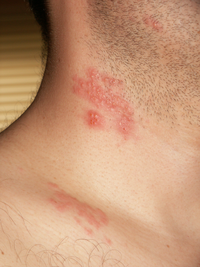Shingles

Shingles (also known as herpes zoster) results from infection by the varicella zoster virus. This common virus causes chickenpox (also known as varicella), which is characterized by itchy spots on the skin that cover the whole body and usually occurs in childhood or adolescence. After the body fights the initial infection, the varicella zoster virus remains in nerve cells for the rest of a person's life. Because the virus is controlled by immune system cells called T cells, it is generally inactive (latent) and typically causes no health problems. However, in some people, the virus becomes active again (reactivates) and causes shingles. Shingles can occur at any age, although it is rare in childhood and becomes more common after age 50.
Shingles is characterized by a severely painful, itchy, or tingling rash, most commonly on one side of the torso, although it can occur anywhere on the body. Reactivation of the virus usually occurs in a single nerve, leading to the symptoms of shingles in just the region of skin connected to that nerve. When the nerve connected to the eye and the skin surrounding it is affected, the condition is called herpes zoster ophthalmicus. This form of shingles, which accounts for about 20 percent of cases, can cause permanent vision impairment.
Some individuals with shingles feel throbbing or tingling in the affected region shortly before the rash appears. Blisters form in the rash area, break open, and scab over in a few days. Healing usually takes 2 to 4 weeks. Most people have only one episode of shingles, although it can recur in rare cases.
In 5 to 20 percent of people with shingles, severe pain continues in the affected region after healing of the rash, which is known as postherpetic neuralgia (PHN). PHN is the most common complication of shingles. It can also involve severe itchiness or an overactive pain response to things that do not usually cause pain (allodynia), such as a light touch. PHN can last weeks, months, or even years. The likelihood of developing PHN after shingles and its severity increase with age. The pain caused by shingles and PHN can disrupt day-to-day activities and reduce a person's quality of life.
Frequency
Because everyone infected with the varicella zoster virus is at risk of developing shingles, the condition is relatively common, particularly in older adults. Shingles occurs in 20 to 30 percent of people at some point in their lives, and about half of people over age 80 have had shingles.
The risk of shingles varies by ethnic background. The condition is more common in people of non-Hispanic white ancestry than those of African American ancestry. For unknown reasons, women are more prone to develop shingles than men.
A vaccine to prevent chickenpox was introduced in the United States in 1995. Since then, the incidence of chickenpox has been reduced by 76 to 85 percent. Doctors suspect the reduction of varicella zoster virus infections will reduce the incidence of shingles as the vaccinated children grow into adulthood; however, it is too early to tell. Vaccines for adults to protect against shingles and subsequent PHN have been used since 2006 and are also expected to reduce the incidence of shingles and its complications.
Causes
The causes of shingles are complex. Development of the condition is influenced by a combination of factors, including age, health, and genetics.
The strongest risk factor for shingles is age. The varicella zoster virus is controlled by the immune system, particularly T cells that keep the virus from infecting other cells. As people age, growth and division (proliferation) of T cells are diminished, reducing the immune system's ability to control the virus, which can allow its reactivation. Health factors that impair T cells can also trigger reactivation of the varicella zoster virus. For example certain drugs, such as chemotherapies used to treat blood cancers like multiple myeloma or drugs that prevent rejection of a transplanted organ, impair the immune system and can lead to virus reactivation. Infection with human immunodeficiency virus (HIV), which infects and kills T cells, can also allow the virus to become active again. In addition, some studies suggest that emotional stress or physical trauma may be involved in virus reactivation.
The role of genetics in shingles is not clear. Several studies indicate that having a family member who developed the condition increases a person's risk, suggesting a shared genetic risk factor, although other studies did not find such a link. Genes that help regulate the immune system have been found in some studies to be associated with the development of shingles or of PHN after shingles. In particular, the risk of developing PHN appears to be increased by certain variants of genes that belong to a family of genes called the human leukocyte antigen (HLA) complex. The HLA complex helps the immune system distinguish the body's own proteins from proteins made by foreign invaders such as viruses and bacteria. It is unclear if certain HLA variations also play a role in the development of shingles.
Learn more about the genes associated with Shingles
Additional Information from NCBI Gene:
Inheritance Pattern
The inheritance pattern of shingles is unclear. Having a first-degree relative (such as a parent or sibling) who developed shingles appears to slightly increase the risk of developing the condition. However, shingles is relatively common in the general population, particularly among older adults, and so it would not be surprising to see more than one case in a family just by chance.